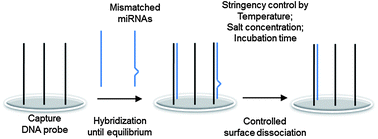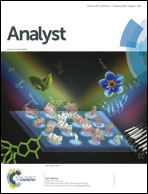Highly improved specificity for hybridization-based microRNA detection by controlled surface dissociation†
Abstract
Poor specificity has been a lingering problem in many microRNA profiling methods, particularly surface hybridization-based methods such as microarrays. Here, we carefully investigated surface hybridization and dissociation processes of a number of sequentially similar microRNAs against nucleic acid capture probes. Single-base mismatched microRNAs were similarly hybridized to a complementary DNA capture probe and thereby poorly discriminated during conventional stringent hybridization. Interestingly, however, mismatched microRNAs showed significantly faster dissociation from the probe than the perfectly matched microRNA. Systematic analysis of various washing conditions clearly demonstrated that extremely high specificity can be obtained by releasing non-specific microRNAs from assay surfaces during a stringent and controlled dissociation step. For instance, compared with stringent hybridization, surface dissociation control provided up to 6-fold better specificity for Let-7a detection than for other Let-7 family microRNAs. In addition, a synthetically introduced single-base mismatch on miR206 was almost completely discriminated by optimized surface dissociation of captured microRNAs, while this mismatch was barely distinguished from target miR206 during stringent hybridization. Furthermore, a single dissociation condition was successfully used to simultaneously measure four different microRNAs with extremely high specificity using melting temperature-equalized capture probes. The present study on selective dissociation of surface bound microRNAs can be easily applied to various hybridization based detection methods for improved specificity.


 Please wait while we load your content...
Please wait while we load your content...